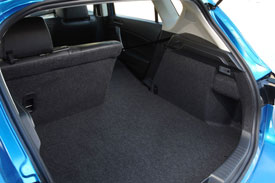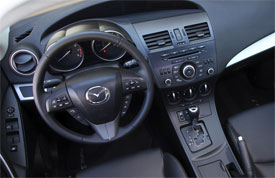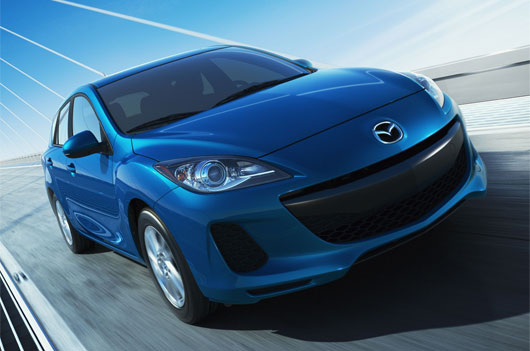2012 Mazda3 SKYACTIV
There have been a slew of new fuel saving power train technologies in recent years from hybrids to full-electrics and even fuel cells. Still, the traditional gasoline or diesel internal combustion engine is far from obsolete, and many would argue it hasn’t come close to its full potential for efficiency, especially when combined with a new whole-vehicle approach to saving fuel. And, that’s just the point of the new Mazda3 SKYACTIV.
 Mazda plans to spread its new SKYACTIV approach across the brand, but it’s the 2012 Mazda3 that is the first to bring much of the technology to market, and that’s fitting as it is Mazda’s best selling model. And one of the big reasons the Mazda3 sedan and 5-Door hatchback are so popular is because of Mazda’s zoom-zoom nature that is fully evident in the 3’s compact chassis. And while that chassis is not all-new for ’12, and therefore doesn’t get the full SKYACTIV effort, it does get an all-new power train, the heart of every fuel saving program.
Mazda plans to spread its new SKYACTIV approach across the brand, but it’s the 2012 Mazda3 that is the first to bring much of the technology to market, and that’s fitting as it is Mazda’s best selling model. And one of the big reasons the Mazda3 sedan and 5-Door hatchback are so popular is because of Mazda’s zoom-zoom nature that is fully evident in the 3’s compact chassis. And while that chassis is not all-new for ’12, and therefore doesn’t get the full SKYACTIV effort, it does get an all-new power train, the heart of every fuel saving program.
The 2-liter SKYACITV-G gasoline I4 puts out 155-horsepower, up 5-percent and 148 pound feet of torque, up 10%; all thanks to both intake and exhaust variable valve timing, direct injection, and a hefty 12-to-1 compression ratio. Low-friction transmissions are new as well, and both manual and automatic are efficient 6-speeds.
All of that makes for Government Fuel Economy Ratings of 28-City and 40-Highway for our SKYACTIV-Drive automatic. That’s a solid 20% boost over the non-SKYACTIV 2.0. The manual rates slightly lower. We average 33 miles-per-gallon of Regular in real world driving. SKYACTIV also helps the Mazda3 get a very good Energy Impact Score, burning through just 10.4-barrels of the black stuff, while emitting just 4.5 tons of CO2 per year.
As to the ‘whole car’ fuel saving aspects, the updated styling also improves aerodynamics. That includes a new front fascia with redesigned grille opening for better airflow management. Additional covers under the car help keep the air moving smoothly as the new Mazda3 sedan cuts through air with 7% less drag than before. SKYACTIV models are also set apart by a transparent blue ring in the headlights, and badging. New 16-inch alloy wheels complete the package.
 The transformation inside the cabin is a bit more thorough. A new instrument cluster adds blue accent lighting and there’s new satin trim throughout. The Multi-Information Display is now easier to read, and there’s a new shifter to go along with the new transmission, as well as new fabric choices for the seats. Touring trim adds Bluetooth and our GT a new 265-watt 10-speaker sound system. The Mazda3 is the only vehicle in this class to offer Blind Spot Monitoring. Rear seat legroom is among best-in-class, but we still felt cramped and the long, wide, flat floor trunk looks as if it would hold more than the 11.8 cubic-feet of cargo that it’s rated for.
The transformation inside the cabin is a bit more thorough. A new instrument cluster adds blue accent lighting and there’s new satin trim throughout. The Multi-Information Display is now easier to read, and there’s a new shifter to go along with the new transmission, as well as new fabric choices for the seats. Touring trim adds Bluetooth and our GT a new 265-watt 10-speaker sound system. The Mazda3 is the only vehicle in this class to offer Blind Spot Monitoring. Rear seat legroom is among best-in-class, but we still felt cramped and the long, wide, flat floor trunk looks as if it would hold more than the 11.8 cubic-feet of cargo that it’s rated for.
While the chassis is unchanged mechanically, some additional reinforcements have been added, as well as extra body welds, which helps to give the already solid feeling Mazda3 an even more unyielding feel. Through the cones, the Electro-Hyrdraulic power steering provided good feel and quick response, and the 3 gripped our cold test track well, even with snow tires. Off the line, the fuel-efficient SKYACTIV power train stood up well. The 2-liter has adequate torque right from the get-go and reached 60 in 8.9-seconds. Power quickly levels out, and the full quarter mile passes in a leisurely 16.9-seconds at 86 miles-per-hour.
As to pricing, a well equipped Mazda3i Touring SKYACTIV 4-door begins at $19,245. That’s only $350 more than a comparable non-SKYACTIV sedan. The hatchback adds $600 more to the base price.
While every manufacturer is now shooting for 40 miles-per-gallon in the compact car segment, Mazda’s whole vehicle approach, which includes not sacrificing driving enjoyment, makes the new Mazda3 a hit with us. And as Mazda expands this approach throughout their line-up, with new lighter-weight chassis’s and even diesel engines, we look forward to getting even more SKYACTIV in the future.
Specifications
- Engine: 2-liter SKYACTIV-G I4
- Horsepower: 155
- Torque: 148 lb-ft.
- 0-60 mph: 8.9 seconds
- 1/4 mile: 16.9 seconds @ 86 mph
- EPA: 28 mpg city/ 40 mpg highway
- Energy Impact: 10.4 barrels of oil/yr
- CO2 Emissions: 4.5 tons/yr
2024 Polestar 2
More Range And More Power For The Polestar 2
Volvo is well on their way to making the transition to an all-electric brand, but their sister-brand Polestar is already there. Now, we’ve spent lots of time in their all-wheel drive, five-door Polestar 2, having tested it in 2021, and a year later when a two-wheel drive version arrived. But, EV updates are coming quickly. So, let us be your guide for all that’s new with the Polestar 2.
While we are driving more EVs than ever, we’ve also been spending a lot of time recently circling back to ones we’ve previously tested. As in this new era of electrified vehicles, significant updates are arriving quickly, with R&D investments increasing and retrofitting them easier than ever. This is often done through software updates that can even be accomplished over the air. For 2024, the Polestar 2 has indeed gotten some software updates, but some physical ones as well.
Clearly aimed directly at Tesla’s Model 3 when it arrived; the Polestar 2’s build quality was vastly better, but range definitely came up short. So, addressing that was priority No. 1; and for ’24 the Polestar can travel up to 20% farther than before while consuming 9% less energy, and when it comes time to charge it back up, it can do that 34% faster too.
Range in the Single Motor version increases from a max of 270 to 320 miles thanks to a larger 82-kWh battery pack, and that solitary motor now powers the rear wheels, not the front wheels. It’s also bigger, coming in at 220 kW compared to the previous 170 kW front-wheel drive version, going from 231 to 299 horsepower.
Dual Motors keep the same 78-kWh battery, but still sees a boost from 260 to 276 miles and takes advantage of the larger rear motor for a new combined 310-kW output with 421 horsepower. Our test car has the added Performance Pack, which uses an additional 35 kW to deliver 455 horsepower and 546 lb-ft of torque, though max range drops to just 247 miles.
The new battery in rear-drive 2s will also charge faster, now accepting up to 205 kW for an 80% charge in 20 minutes; max for dual-motors stays at 155 kW, which puts an 80% charge at 34 minutes. Using 32 kWh of electricity per 100 miles, the Dual Motor earns a good efficiency rating.
The [Polestar] 2 has always been one of the most enjoyable EVs to drive, even more so now with that additional power coming from the rear motor.
Unfortunately, extremely cold temperatures kept us from seeing that increased range, as we were only on pace for about 194 miles in our test.
The 2 has always been one of the most enjoyable EVs to drive, even more so now with that additional power coming from the rear motor. And especially when equipped with the Performance Pack as it not only includes more power, but adds 20-inch forged wheels, upgraded brakes, and adjustable Ohlins Dual Flow Valve performance dampers. It greatly improves handling prowess without affecting ride quality, and is easily worth the $5,500 charge if you at all enjoy driving.
Even on a 20-degree track day there was plenty of grip through our handling course. No understeer or oversteer, and lots of feedback through the wheel. There was a nice, strong launch off the line that properly planted us firmly in the seat, and rocketed us to 60 in 4.5 seconds. Power delivery stayed pretty intense up until about 80 mph when there was a definite tapering off. Still, it was a 13.4-second quarter-mile at 102 mph; smooth, quiet, and stable the whole way.
When this car debuted, its Google-based infotainment setup was a novelty, but since then, more and more manufacturers are just “Googling it” so it doesn’t seem out of place at all. The wireless phone charger is easy to access, and there’s a great Harmon/Kardon sound system and panoramic sunroof to enhance the in-cabin experience. Exteriors have also been enhanced with a smooth grille insert and new wheel choices.
Hatchback practicality means 14.3 cu-ft of easy to access cargo space with split-folding seatbacks for longer items and expanding the space to 38.7 cu-ft. Plus, there’s even a sizeable storage bin up front under the hood.
Single Motor Polestar 2 pricing now starts at $51,300, with Dual Motors starting at $56,700; topping out at $64,400.
For a car manufacturer that hasn’t even been around for a decade yet, Polestar has kept itself busy, totally transforming their latest model in just a few years, making the 2024 Polestar 2 even more appealing. They are certainly off to a good start, and with a host of Polestars just over the horizon, including some all-important utility vehicles, this star will be shining even brighter.
Specifications
As Tested
- Motor Setup: Dual Motor
- Horsepower: 455
- 0-60 mph: 4.5 seconds
- EPA Range: 247 miles
- Efficiency : 32 kWh / 100 miles
- Battery Size: 78-kWh
- Torque: 546 lb-ft
- 1/4 Mile: 13.4 seconds at 102 mph
- MW Test Loop: ~ 194 miles
- Peak Charging Rate: 155 kW











































